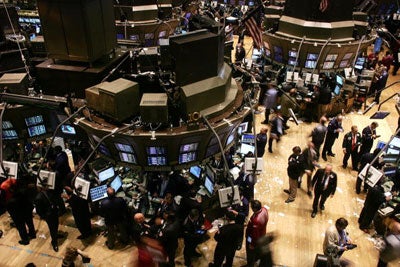Did anyone actually read that latency arb PDF I posted.
Its not just a speed game, that alone would be tough enough.
The Latency arb HFT's see all the orders and trades before anyone else...
Extracts from here:
http://www.themistrading.com/articl..._--_Latency_Arbitrage_--_December_4__2009.pdf
http://www.trade2win.com/boards/first-steps/145690-scalping-10.html#post1805484
-----------------------------------------------------------------------------------------------
EXTRACT 1:
The Reality of Latency Arbitrage:
In practice, however, Latency Arbitrage means something completely different to HFTs.
Firstly, it is about using cutting edge technology and co-located servers at exchanges and ATSs, combined with
purchases of
raw data feeds from these market centers, to create one’s own inside National Best Bid and Offer
(NBBO) quote and depth of book substantially earlier than what is publicly available from the Security
Information Processor, or SIP quote. The SIP feeds quotes seen on professional terminals, algo trading
systems used by institutions for as much as 50% of their orders, and quotes seen by retail investors on Internet
sites.
EXTRACT 2:
Do HFT firms have an unfair
advantage? Most professionals on Wall Street have taken a standard from our past for granted, that
everyone sees the same quote and market data at the same time.
What if the time differential between
what the HFTs see and what everybody else sees was 5 minutes instead of 5 milliseconds? Would that be
acceptable? It is not the amount of time that matters. It’s that a differential exists at all. Who would bet on
a horse race if a select group already knew who won?
EXTRACT 3:
Latency Arbitrage has created a two-tiered market of technology enhanced insiders (comprised of a handful
of large banks, brokerage firms and hedge funds) and the rest of us. To be clear, HFTs only enjoy this
advantage because market centers are selling them the right to co-locate and access raw data feeds. As
for-profit organizations, market centers are incentivized to do this. Which leads us to question number two:
Is it fair to sell these rights to the highest bidders when market centers are supposed to be protecting all
participants’ interests equally? At the end of the day, aren’t
market centers charging HFTs a higher fee in
exchange for giving them an advance look at the NBBO?
EXTRACT 4:
HFTs use Latency Arbitrage to re-engineer the NBBO from end sources directly versus relying on the publically
available standard SIP quote. HFTs are able to do this by paying exchanges and ATSs for the right to locate
their servers next to market center data servers and matching engines and the right to access raw data feeds.
As a result, HFTs know with near certainty what the market will be milliseconds ahead of everybody else –
valuable knowledge that HFTs take advantage of when they trade thousands of stocks, thousands of times,
every trading day. For HFTs, it is like shooting ducks in a barrel of honey. For all other institutional and retail
investors, it is death by a thousand cuts.
To date, this situation has been tolerated because most investors were unaware that two different quotes
existed and could not fathom that those in charge of overseeing the markets would allow this to happen. Why
would most investors assume that they looked at different quotes? Why would most investors assume that they
weren’t watching the same horse race? Now we are at a crucial juncture in terms of our financial market’s
structure. The time has come for us to ask, “Is short-term fleeting liquidity (in our most liquid names) worth the
tradeoff of accepting a multi-tiered and unequal market?”
-----------------------------------------------------------------------------------------------
Again just to be clear, not knocking anyone or saying you can't do it.
If it works for you, more power to ya.
Lets not kid anyone though that the odds are against you with retail quotes and consumer net connections.
Under those conditions, scalping for 1 tick as a retailer where is the edge?
I would concede that a retailer may be catching the VWAP algo moves that
were suckered in by the latency arb HFT in the first place...now that is irony
🙂


